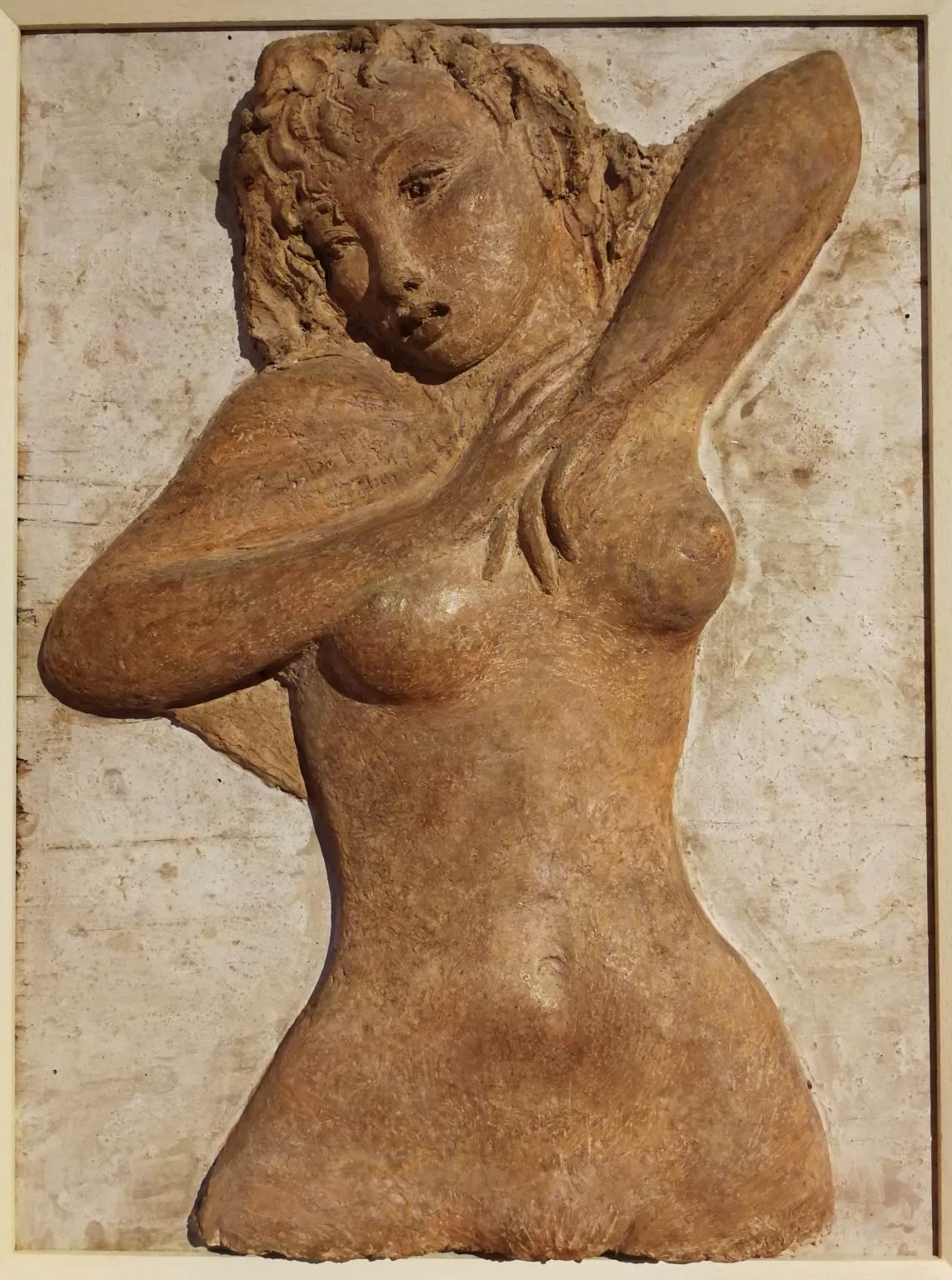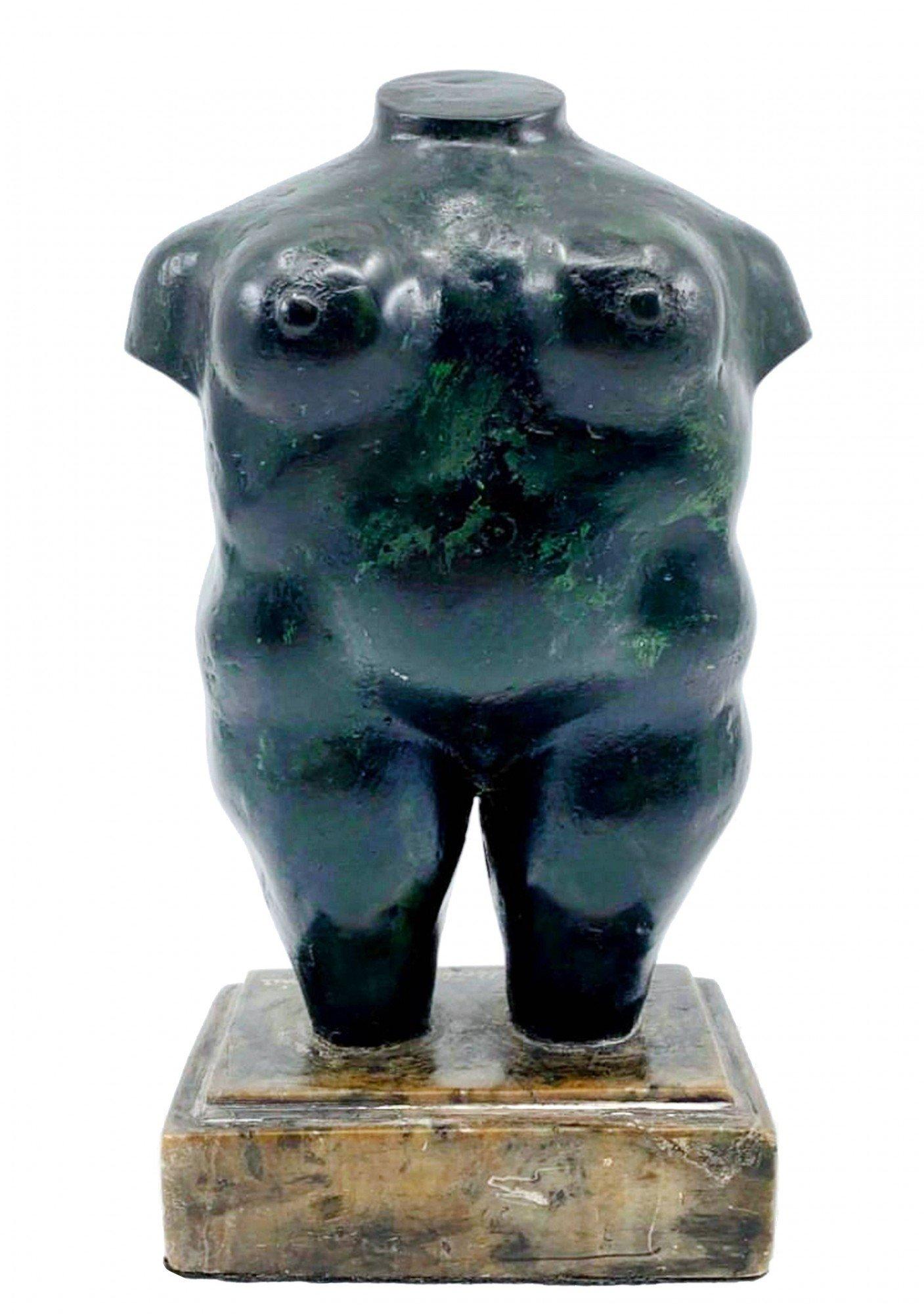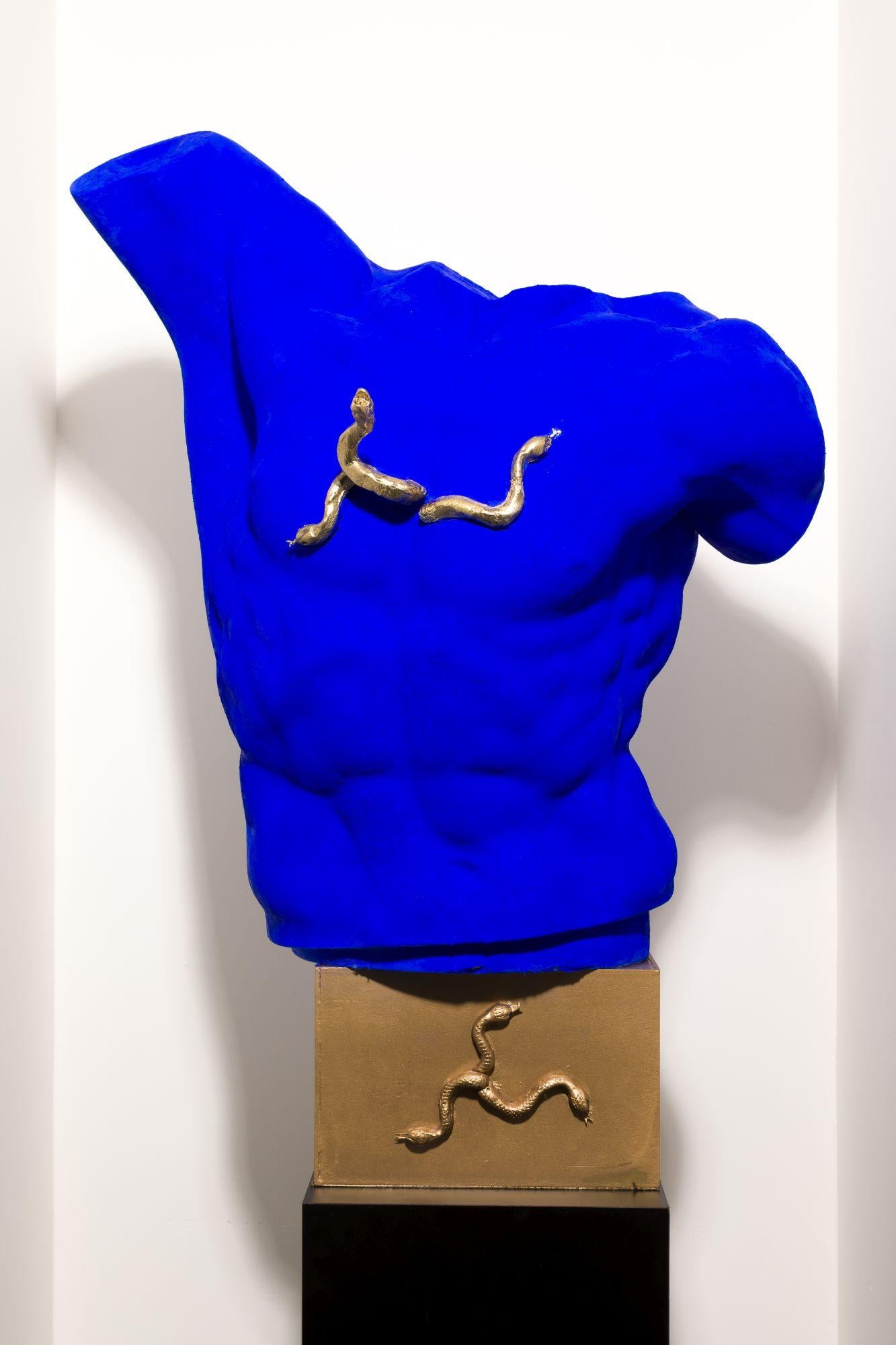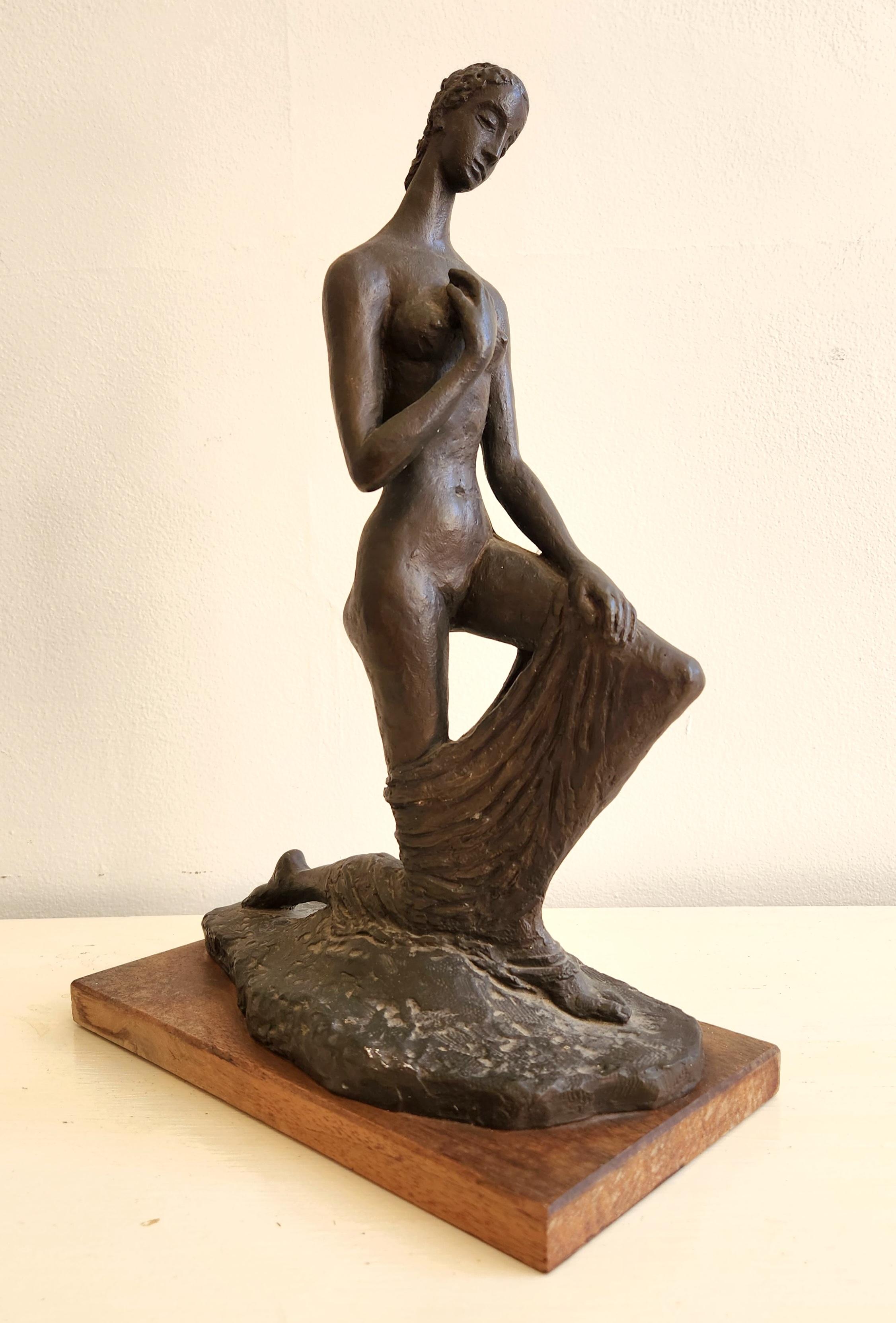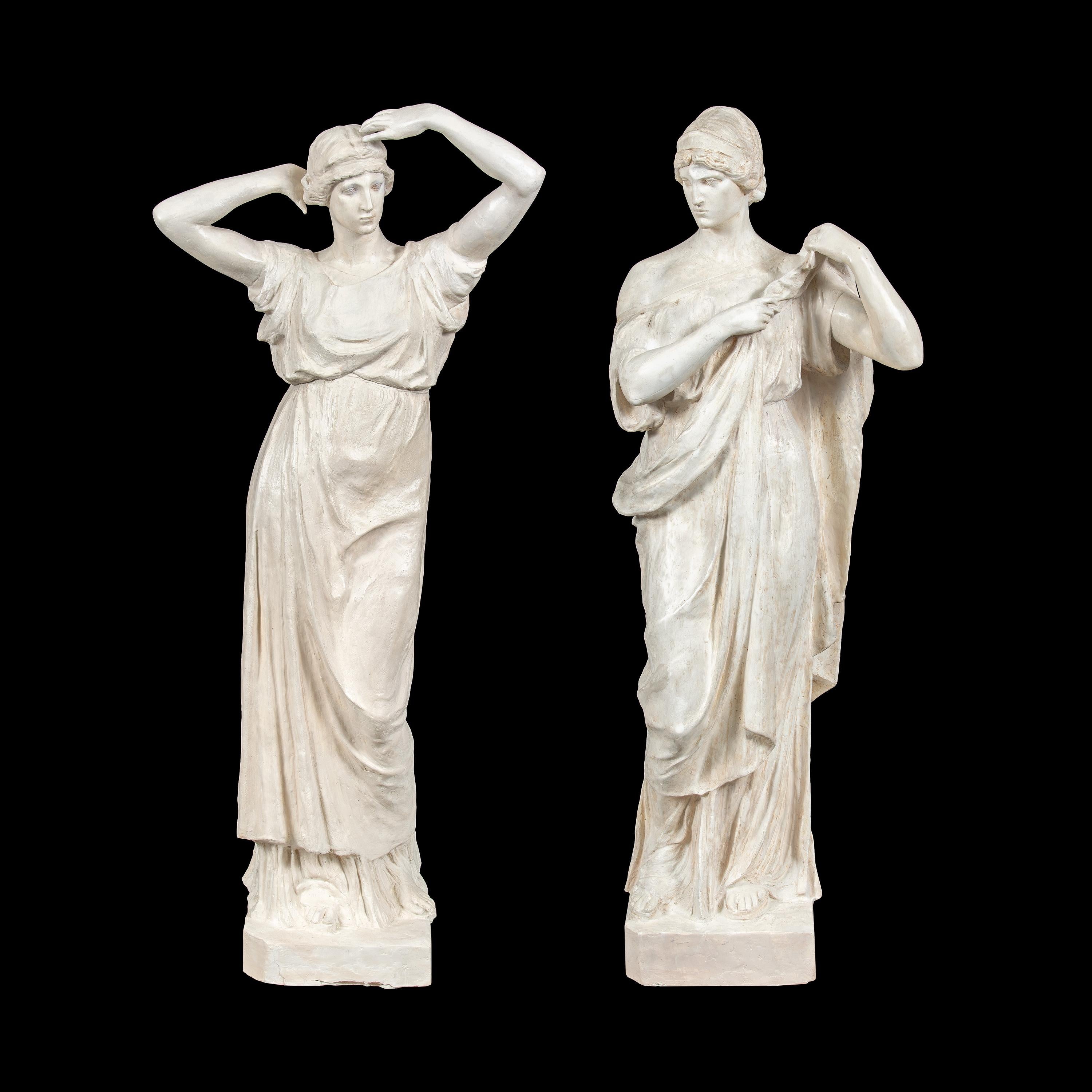Items Similar to Richard Garbe - Helios - Early 20th Century British patinated plaster sculpture
Want more images or videos?
Request additional images or videos from the seller
1 of 9
Richard GarbeRichard Garbe - Helios - Early 20th Century British patinated plaster sculpture1929
1929
About the Item
RICHARD LOUIS GARBE, RA
(1876-1957)
Helios
Signed and dated 1929
Plaster with patinated surface
86 cm., 33 ¾ in. high
Garbe was born in Dalston, London, the son of Gustave Garbe, a carver of ivory and manufacturer of tortoiseshell fancy goods, to whom he was apprenticed. He later studied at the Central School of Art and at the Royal Academy Schools. He began exhibiting at the Royal Academy in 1908. He taught sculpture at the Central School 1901-29 and was Professor of Sculpture at the Royal College of Art, 1929-46. He was elected an Academician at the Royal Academy of Arts in 1929 and full Academician in 1936. In 1929 he was elected a Fellow of the Royal British Society of Sculptors, while in 1938 he was elected as a Master of the Art Workers’ Guild. He is represented in many major public collections including the Tate Gallery and Victoria & Albert Museum.
A large bronze version of this piece was sold by the Fine Art Society in 2015
Helios, the Greek god of the sun is depicted rising into the sky with his radiant crown about is head. He is leaving his lover, the goddess Rhodos, after whom the island of Rhodes is named.
- Creator:Richard Garbe (1876 - 1957, British)
- Creation Year:1929
- Dimensions:Height: 33.86 in (86 cm)Width: 17.33 in (44 cm)
- Medium:
- Movement & Style:
- Period:
- Condition:
- Gallery Location:London, GB
- Reference Number:

About the Seller
4.9
Vetted Seller
These experienced sellers undergo a comprehensive evaluation by our team of in-house experts.
Established in 2004
1stDibs seller since 2018
50 sales on 1stDibs
Typical response time: 15 hours
- ShippingRetrieving quote...Ships From: Banbury, United Kingdom
- Return PolicyA return for this item may be initiated within 14 days of delivery.
More From This SellerView All
- The Falconer, Art Deco British Plaster Sculpture by Richard Garbe RABy Richard GarbeLocated in London, GBRICHARD GARBE, RA (1876-1957) The Falconer Signed and dated on the reverse: Richard Garbe, ARA / 1932 Patinated plaster 49.5 cm., 19 ½ in. high Proven...Category
1930s Art Deco Figurative Sculptures
MaterialsPlaster
- Edward Carter Preston - Athena - 20th Century British Plaster Sculpture FigureLocated in London, GBEDWARD CARTER PRESTON (1885-1965) Athena Signed: E CARTER PRESTON Bronzed plaster 59 cm., 23 ¼ in. high Edward Carter Preston is best known as the designer of the bronze memorial...Category
Early 20th Century Realist Figurative Sculptures
MaterialsPlaster
- Alfreda, The Artist's Daughter - British 1950s plaster bust by Richard GarbeBy Richard GarbeLocated in London, GBRICHARD LOUIS GARBE, RA (1876-1957) Alfreda, The Artist’s Daughter Signed and dated 1956 Plaster with patinated surface on a wooden base 30 cm., 11 ¾ in. high Provenance: Gifted ...Category
1950s Realist Figurative Sculptures
MaterialsPlaster
- St CeciliaLocated in London, GBD. BRUCCIANI & CO (19th Century) St Cecilia Polychrome painted plaster bust with mould lines visible (probably later painting) 47 cm., 18 ½ in. high Dom...Category
1870s Renaissance Figurative Sculptures
MaterialsPlaster
- Gilbert Ledward - 1930s Watercolour Design for a Decorative Sculptural FriezeLocated in London, GBGILBERT LEDWARD, RA, PRBS (1888-1960) Tennis, Golf, Shooting, Ice-Skating, Dreaming – Proposed Design for Decorative Frieze in the Italian Drawing Room at Eltham Palace, commissioned by Stephen Courtauld Signed and dated July 9th 1933 Watercolour and pencil 12.5 by 49.5 cm., 5 by 19 ½ in. (frame size 36 by 67 cm., 14 ¼ by 26 ¼ in.) Exhibited: The artist’s daughter; London, The Fine Art Society, A Centenary Tribute, Feb 1988, no. 43. Gilbert Ledward was born in London. He was educated at St Mark’s College, Chelsea. In 1905 he entered the Royal College of Art to study sculpture under Edouard Lanteri and in 1910 he entered the Royal Academy Schools. In 1913 he won the Prix de Rome for sculpture, the Royal Academy’s travelling award and gold medal, which allowed him to travel in Italy until the outbreak of the Wold War I. During the war he served as a lieutenant in the Royal Garrison Artillery and was appointed as an official war artist in 1918. Following the war he was largely occupied as a sculptor of war memorials including the Guards Division memorial in St James’s Park and the Household Division’s memorial in Horse Guards Parade. In 1934, supported by Eric Gill and Edwin Lutyens, he established a company called Sculptured Memorials and Headstones, which promoted better design of memorials in English churchyards. His war memorials after World War II include one in Westminster Abbey to the Submarine Service, Commandos and Airborne Forces. Ledward was Professor of Sculpture at the Royal College of Art (1927-1929) and in 1937 was elected at Royal Academician. He became President of the Royal Society of British Sculptors and a trustee of the Royal Academy. The present work is a design for an intended decorative frieze for the Italian Drawing Room of Eltham Palace. In 1935 the remains of the medieval royal palace of Eltham was rescued from decay by Stephen and Virginia Courtald who built an ultra modern Art Deco house to adjoin the existing Great Hall. They employed the architects John Seeley and Paul Edward Paget and the fashionable Mayfair interior designer the Marchese Peter Malacrida to design the strikingly glamorous 1930s interiors of the new house. The dramatic entrance hall was created by the Swedish designer Rolf Engstromer...Category
1930s Art Deco Figurative Sculptures
MaterialsWatercolor
- Alfred Stevens - 19th Century British Bronze Figure of JudithBy Alfred StevensLocated in London, GBALFRED STEVENS (1817-1875) Judith Bronze 22 cm., 8 ¾ in. high Provenance: Handley-Read Collection; Fine Art Society, London, 1979; Collection of Peter Rose and Albert Gallichan. ...Category
Mid-19th Century Realist Figurative Sculptures
MaterialsBronze
You May Also Like
- Signed Bruno Innocenti Female Nude Sculpture Relief 20 century plaster woodBy Bruno InnocentiLocated in Florence, ITThe bass-relief is made of plaster painted with the warm color tone of the earth in order to represent terracotta. The subject is a juvenile girl, as we can see by the tenderness and...Category
Mid-20th Century Post-War Nude Sculptures
MaterialsTerracotta, Plaster, Wood Panel
- 20th Century Nude Torso, boteroesque sculpture, contemporary Colombian artistLocated in Beachwood, OHAlberto Echevarria (Colombian, 20th Century) Nude Torso Cast plaster with patina, on carved marble base Signed on base 8 in. h. x 4 in. w. x 2.75 in. d. Inscribed “Made in Medellin (...Category
20th Century Contemporary Nude Sculptures
MaterialsMarble
- LaocoonBy Raphaël Jaimes-BrangerLocated in Boston, MAPlaster, Gold Leaf. Signed and titled in pencil on base. Stamped with a wax seal.Category
2010s Contemporary Figurative Sculptures
MaterialsGold Leaf
- Industrial Machine Age American Scene WPA Mid 20th Century 1939 SF World's FairLocated in New York, NYIndustrial Machine Age American Scene WPA Mid 20th Century 1939 SF World's Fair HAIG PATIGIAN (American/Armenian, 1876-1950) Aeronautics Pediments Two Plaster Casts, c. 1930s each 13.25 x 14.75 x 6 inches It's possible these moquettes were created for the 1939 World's Fair, the Golden Gate International Exhibition in San Francisco. Provenance: Private Collection of Lois M. Wright, Author of "A Catalogue of the Life Works of Haig Patigian, San Francisco Sculptor, 1876-1950),” 1967 Loan to Oakland Museum of California (Oakland, CA) BIO Haig Patigian is noted for his classical works, which are especially numerous in public venues in San Francisco, California. Patigian was born in Van, Armenia, which at that time was under Turkish rule. Haig was the son of Avedis and Marine Patigian, both teachers in the American Mission School there. He and his older brother showed an aptitude for art early on and were encouraged by their parents. Their father himself had taken up the new hobby of photography. The 1880s were harsh times, however, for many Armenians under an oppressive rule by the Turkish government. Many people were fleeing to the safety of the United States. Suspicious Turkish authorities accused his father of photographing city structures for the Russian government, and in 1888 he fled for his life to America. Haigs father made his way to Fresno, California, and began life anew as a ranch hand. Within two years he sent for his wife, as well as Haig, his three sisters and brother, and in 1891 the Patigians made the journey from Armenia. Haigs father, an industrious man, worked on various farms, and eventually bought his own ranch and vineyard. It was among fertile farmland of Fresno that Haig grew up. Young Haigs education consisted of teachings by his parents and by intermittent attendance in public schools. Although he had dreams of becoming an artist, he did not have the opportunity for formal study of art, and began working long days in the vineyards around Fresno. At age seventeen, Haig made a step towards his dreams and apprenticed himself to learn the trade of sign painting. In his spare time he nurtured his interest in art by painting nature and life scenes with watercolors and oil paints. When his sign-painting mentor left Fresno, Haig opened his own shop and made a name for himself in the town. San Francisco, in the meantime, had been attracting artists since the Gold Rush and had become a thriving art center. Within a few years, Haig had put aside several hundred dollars to move to San Francisco, joining his brother who was already working there as an illustrator. In 1899, when he was twenty-three, Haig had saved enough money to enroll at the Mark Hopkins Art Institute in San Francisco. Like many aspiring artists of his time, Patigian supported himself by working as a staff artist in the art department of a local newspaper, and in the winter of 1900, nearing his 24th birthday, Haig began work for the San Francisco Bulletin, producing cartoons, black and white illustrations, as well as watercolors. In 1902 tragedy struck Haig and his family. His 29-year-old brother died of pneumonia, and then his frail mother died a short time later. Five months more saw his youngest sister, just out of high school, die too. Saddened and depressed, Haig moved out of the studio he had shared with his brother, and into a dilapidated studio in a poor section of town. During this time of sadness, Haig fed a growing interest in sculpture. In 1904 Haig created what he later called his "first finished piece in sculpture". The work, called "The Unquiet Soul", depicted a man thrown back against a rock while waves lash at his feet. The body was tense and twisted, with one hand, in Haig's own words, "searchingly leaning and clutching the rock, while the other masks his troubled head". The Press Club of San Francisco, which Haig had joined in 1901, put "The Unquiet Soul" on exhibition and local headlines proclaimed "Local Newspaper Artist Embraces Sculptor's Art", and "First Work Predicts Brilliant Future". With the support of friends and community acclaim, the young illustrator left his newspaper job and became a professional sculptor. The path of his new career was not easy though. Haig had never made much money working for the newspaper and his father needed help with growing debt from funeral expenses and business problems. From time to time Haig sold some artwork, but also occasionally borrowed from friends to pay the rent. He was the classic 'starving artist'. In the spring of 1905 a white-bearded 81-year-old stranger knocked on Haig's door. It was George Zehndner, from Arcata, California. Zehndner had been born in Bavaria, Germany in 1824, the son of a farmer. In 1849 he had come to America looking for prosperity, settling in Indiana, where he worked on a farm and learned English. He found his way to the West Coast in 1852. Penniless, he worked in various jobs from San Francisco to Sacramento, then found some luck working in the gold fields of Weaverville in Trinity County, and eventually moving to a farm on 188 acres near Arcata. In his 77th year in May of 1901, Zahndner had taken a trip to San Jose, where he stood in a crowd to see a man he thought much of, President William McKinley. McKinley was popular as 'the first modern president' partially because he realized going out to meet the common person increased his support. In September of that year, however, an anarchist assassinated the president while he stood in a receiving line at the Pan-American Exhibition in Buffalo, New York. Soon after, the city of San Jose erected a statue of the slain president in St. James Park. Zehndner took a second trip to San Jose where he visited the McKinley monument. Touched, Zehndner decided that, no matter the cost, his town of Arcata too would memorialize McKinley. George Zehndner had read about Haig in a newspaper article and asked if Patigian would create a heroic statue of the late President McKinley for Arcata. When asked how much it would cost, Haig responded, despite his borderline poverty, with the fabulous sum of $15,000. Zehndner agreed. The President was to be portrayed standing, wearing an overcoat, with his feet planted squarely on the ground. In the finished statue, one hand is held out before him in a typical posture of speaking, with the other hand holding the speech as his side. The 9-foot statue...Category
1930s American Modern Figurative Sculptures
MaterialsPlaster
- Replica of Wilhelm Lehmbruck's Kneeling WomanLocated in Troy, NYThis sculpture is a small replica of Wilhelm Lehmbuck's Kneeling Woman. The original sculpture is much larger at around 69.5 x 56 x 27", currently at th...Category
1960s Expressionist Nude Sculptures
MaterialsWood, Plaster
- Neoclassical sculpture in Rome- Pair of 19th century Italian scagliola - FiguresLocated in Varmo, ITPair of scagliola sculptures - Roman figures. Italy, 19th century. 51 x 26 x h 118 cm (left) - 41 x 28 x h 118 cm (right). Entirely in scagliola. Condition report: In good general...Category
Early 19th Century Old Masters Figurative Sculptures
MaterialsPlaster
Recently Viewed
View AllMore Ways To Browse
Sculpture In The 20th Century
Antique Sculpture Art Sculptures
Antique Art Sculptures
Antique Plaster
Crown Sculpture
Antique Bronze Sculpture Signed Art Sculptures
God Sculpture
Art Deco Patinated Bronze
Plaster Collection
Collection Of Plasters
Antique Art Deco Sculpture
Art Deco Crown
Antique Greek Sculpture
British Art Deco
Antique Sculptures London
Antique Sculpture London
Antique Goods
Fine Plaster
